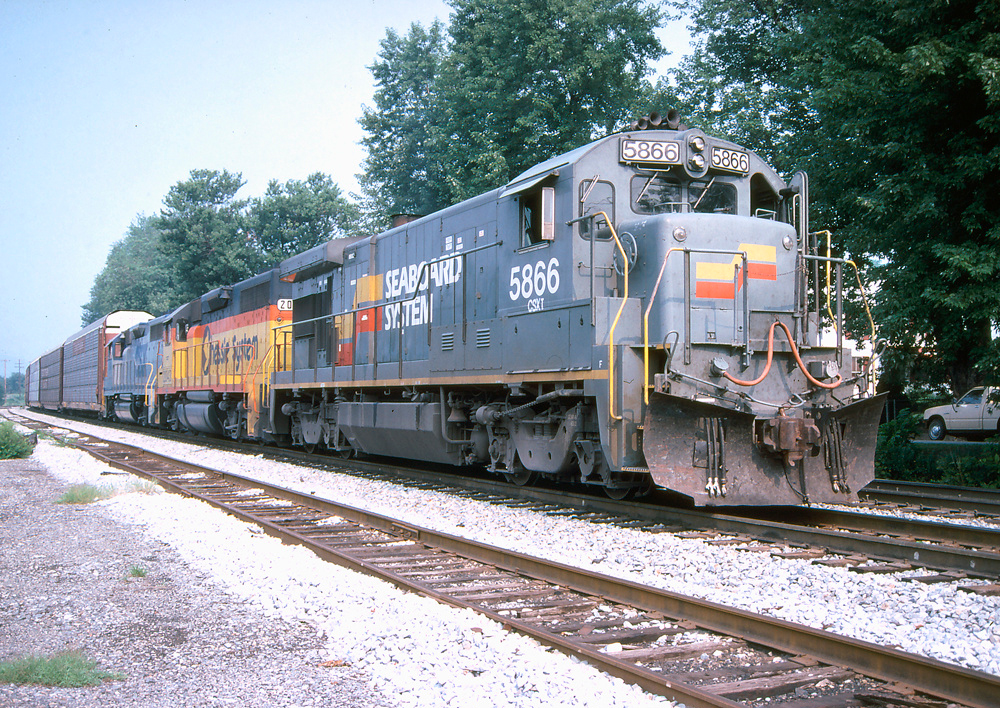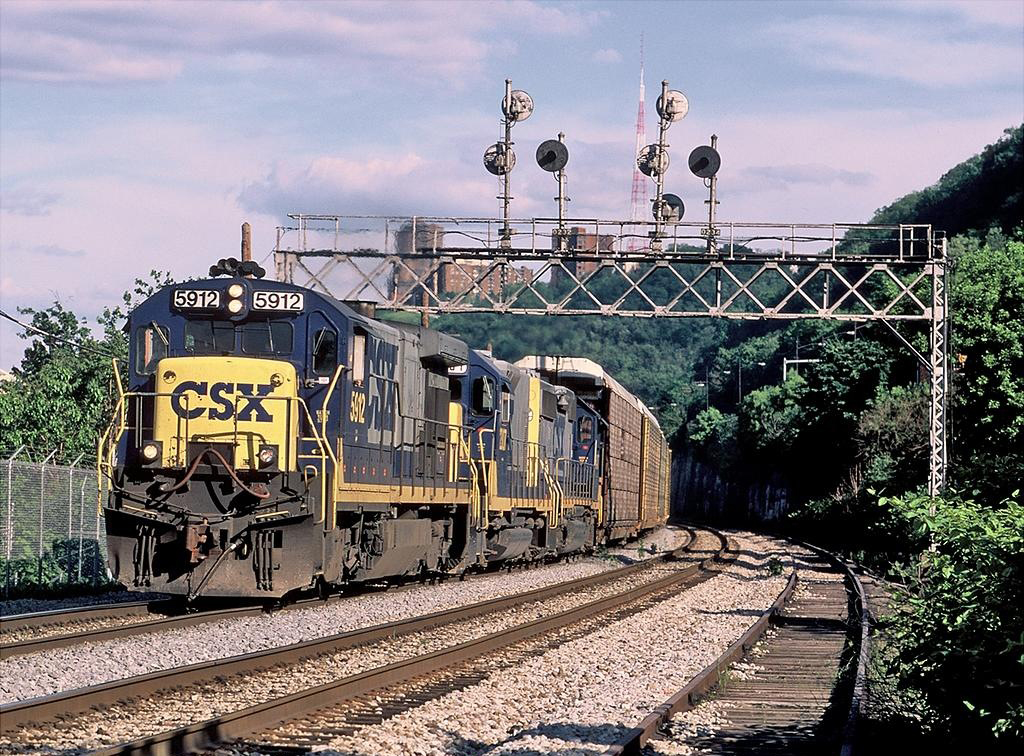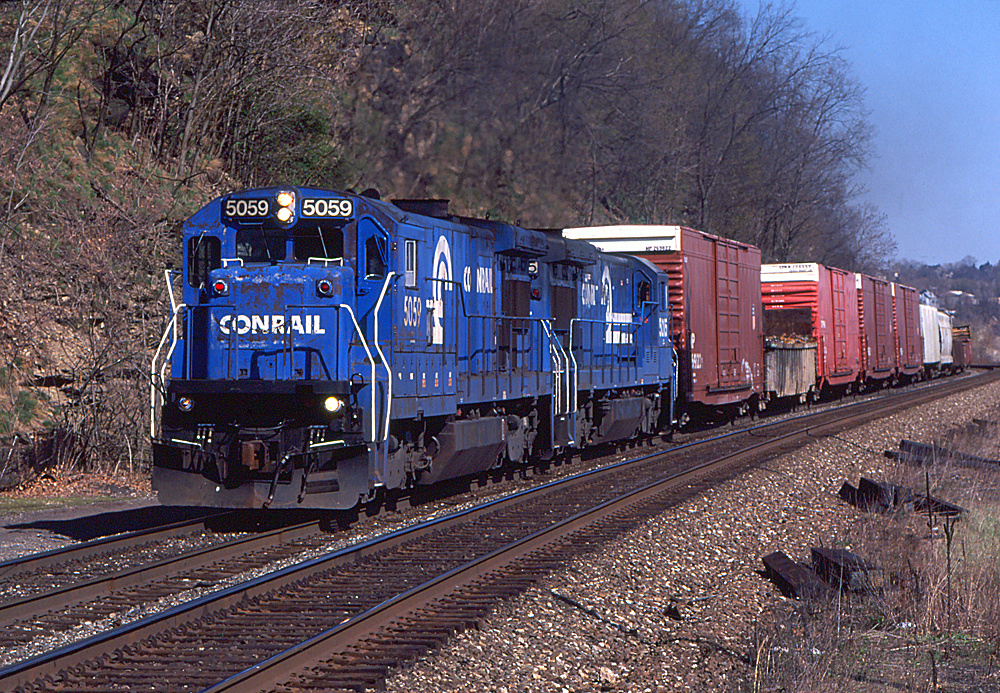GE "B36-7" Locomotives: Specs, Roster, History
Last revised: January 1, 2025
By: Adam Burns
The B36-7 was General Electric's most powerful four-axle "Dash 7" model. It, along with the earlier B30-7, was designed for high-speed freight service over relatively level grades where high tractive effort was unnecessary.
By the time the model was cataloged, railroads had largely lost interest in such designs, citing increased maintenance costs associated with high horsepower designs.
Interestingly, General Electric continued to offer four-axle designs as late as 1990 with its B40-8W, part of its later "Dash 8" series.
The B36-7 was the final four-axle model to feature the Universal series, boxy carbody with a short nose and light beveling.
The later "Dash 8" series featured sharper lines and angles, a higher short nose, a more pronounced sharp "winged" radiator, and the first variants of General Electric's "wide cabs."
While the B36-7 had the fewest sales of the "Dash 7" line, ex-Seaboard units remained in use on CSX until late 2009. Today, all "Dash 7s" have been retired from Class I rosters.
Photos
 It's the early CSX era as a former Seaboard System B36-7, #5866, leads an eastbound autorack train into Brunswick Yard at Brunswick, Maryland on August 11, 1988. Wade Massie photo.
It's the early CSX era as a former Seaboard System B36-7, #5866, leads an eastbound autorack train into Brunswick Yard at Brunswick, Maryland on August 11, 1988. Wade Massie photo.Overview
As Greg McDonnell notes in his book, "Locomotives: The Modern Diesel & Electric Reference, 2nd Edition," the B36-7 was a direct successor to the earlier B30-7.
And typical of GE practice, it was not given much fanfare. The first units were actually a group of upgraded B30-7's, St. Louis Southwestern Railway (Cotton Belt) #7770-7773, which rolled out of Erie in January of 1980.
These units were actually part of a larger batch of B30-7s Southern Pacific's subsidiary had ordered that year numbered 7774-7799.
They came equipped with a number of new GE gadgets including the builder's latest traction motors (752AF), GTA24 alternators, and the Sentry adhesion-control system.
The Southern Pacific was pleased with these testbed examples and the new model entered GE's catalog. The first buyer was the Santa Fe, which picked up 16 examples in October and November, 1980.
Reception
The B36-7 did not enjoy strong sales, outshopping roughly half as many units as the earlier B30-7. In fact, the Seaboard System, alone, accounted for over half of all orders, acquiring 120 examples.
While both GE and EMD continued offering high horsepower, four axle models into the mid-1980s, most of the industry had given up on the design by that time.
Their lower tractive efforts made them undesirable in drag service and their six-motored counterparts could still handle freights at relatively high speeds when needed.
 CSX B36-7 #5912 has westbound freight Q249 on the Pittsburgh Subdivision as it passes beneath the Pittsburgh Sub, passing the Corliss signal bridge at Corliss, Pennsylvania (Pittsburgh) on June 8, 1997. Wade Massie photo.
CSX B36-7 #5912 has westbound freight Q249 on the Pittsburgh Subdivision as it passes beneath the Pittsburgh Sub, passing the Corliss signal bridge at Corliss, Pennsylvania (Pittsburgh) on June 8, 1997. Wade Massie photo.From the railroads' standpoint, four-axle models lacked redundancy in addition to featuring higher maintenance costs typical of high horsepower locomotives.
The introduction of the "Dash 7" line brought with it new designations and meanings. In regards to the B36-7:
- "B" referred to a four-axle (B-B) locomotive.
- "36" designated the horsepower rating of 3,600.
- "7" indicated that the "Dash 7" line was introduced in 1977.
As always, the model came equipped with GE's 4-cycle model 7FDL16 prime mover utilizing the company's very reliable, and latest, 752AF traction motors. The locomotive could produce 70,000 pounds of starting effort and 63,250 pounds of continuous effort at 10.7 mph.
By the 1980s GE had a steady following by some, such as Conrail and Seaboard, the latter of which purchased the most. Additionally, the Cerrejon Coal Project of Columbia acquired eight units. In all, General Electric sold some 230 examples by the time production was ended in September, 1985.
Data Sheet and Specifications
| Entered Production | 1/1980 (St. Louis Southwestern #7770-7773) |
| Years Produced | 1/1980 - 9/1985 |
| GE Class | B36-7 |
| Engine | 7FDL16 (16 cylinder) |
| Engine Builder | General Electric |
| Horsepower | 3600 |
| RPM | 1050 |
| Length | 62' 2" |
| Height (Top Of Rail To Top Of Cab) | 15' 4 1/2" |
| Width | 9' 11" |
| Weight | 259,000 - 280,000 Lbs |
| Fuel Capacity | 2,150 Gallons |
| Air Compressor | 3CDC (Westinghouse) |
| Air Brake Schedule | 26NL (Westinghouse) |
| Trucks | B-B |
| Truck Type | Floating Bolster FB2 (GE) |
| Truck Wheelbase | 9' 0" |
| Wheel Size | 40" |
| Traction Motors | 752AF (4), GE |
| Traction Alternator | GTA24AC, GE |
| Auxiliary Generator | GY27, GE |
| MU (Multiple-Unit) | Yes |
| Dynamic Brakes | Yes |
| Gear Ratio | 83:20 |
| Tractive Effort/Starting | 70,000 Lbs |
| Tractive Effort/Continuous | 63,250 Lbs at 10.7 mph |
| Top Speed | 70 mph |
Production Roster
(Total Built = 230)
| Owner | Road Number | Serial Number | Order Number | Completion Date | Quantity |
|---|---|---|---|---|---|
| St. Louis Southwestern Railway (Southern Pacific) | 7770-7773 | 42784-42787 | 1441 | 1/1980 | 4 |
| Santa Fe | 7484-7499 | 43130-43145 | 1447 | 10/1980-11/1980 | 16 |
| Southern Railway | 3815-3820 | 43156-43161 | 1431 | 3/1981 | 6 |
| Exxon - Columbia | 1001-1004 | 43294-43297 | 1441 | 8/1983 | 4 |
| Exxon - Columbia | 1005-1008 | 43787-43790 | 1402 | 9/1984 | 4 |
| Southern Pacific | 7754-7769 | 43791-43806 | 1403 | 11/1984-12/1984 | 16 |
| Conrail | 5000-5048 | 44251-44299 | 1443 | 12/1983 | 49 |
| Conrail | 5049-5059 | 44400-44410 | 1443 | 12/1983 | 11 |
| Seaboard System | 5806-5880 | 44809-44883 | 1405 | 2/1985-6/1985 | 75 |
| Seaboard System | 5881-5925 | 44970-45014 | 1406 | 7/1985-9/1985 | 45 |
Sources
- Foster, Gerald. A Field Guide To Trains. New York: Houghton Mifflin, 1996.
- Marre, Louis A. and Pinkepank, Jerry A. Contemporary Diesel Spotter's Guide, The: A Comprehensive Reference Manual To Locomotives Since 1972. Milwaukee: Kalmbach Publishing Company, 1989.
- McDonnell, Greg. Locomotives: The Modern Diesel & Electric Reference, 2nd Edition. Buffalo: Boston Mills Press/Firefly Books, 2015.
- Solomon, Brian. American Diesel Locomotive, The. Osceola: MBI Publishing, 2000.
- Solomon, Brian. GE and EMD Locomotives: The Illustrated History. Minneapolis: Voyageur Press, 2014.
- Solomon, Brian. GE Locomotives: 110 Years Of General Electric Motive Power. St. Paul: MBI Publishing, 2003.
 Conrail B36-7 #5059 leads a westbound local back to Conway Yard at Emsworth, Pennsylvania on April 20, 1997. Wade Massie photo.
Conrail B36-7 #5059 leads a westbound local back to Conway Yard at Emsworth, Pennsylvania on April 20, 1997. Wade Massie photo.Retirement
Despite sales being slow some B36-7's soldiered on in active revenue service for many years with the final units being retired from CSX in the late fall of 2009.
Earlier, Conrail's original fleet of B36-7s were put out to pasture between 2000 and 2001. For GE and EMD, realized by the 1980s that interest in four-axle, high-horsepower locomotives had all but evaporated.
It did catalog the B32-8/W, B36-8, B39-8, and B40-8/W in the mid/late-1980s but, in total, these models sold a combined 400+ examples.
Not even Electro-Motive could sway railroads to acquire its final four-axle models; the GP50, GP59, and GP60 sold slightly better at a little over 700 examples.
Recent Articles
-
Rio Grande 2-8-2 Locomotives (Class K-28): Specs, Roster, Photos
Apr 14, 25 10:24 PM
Rio Grande's Class K-28 Mikados were its newest narrow-gauge steam locomotives since the Mudhens of the early 1900s. Today, three survive. -
Rio Grande K-27 "Mudhens" (2-8-2): Specs, Roster, Photos
Apr 14, 25 05:40 PM
Rio Grande's Class K-27 of 2-8-2s were more commonly referred to as Mudhens by crews. They were the first to enter service and today two survive. -
C&O 2-10-4 Locomotives: Specs, Roster, Photos
Apr 13, 25 04:07 PM
Chesapeake & Ohio's T-1s included a fleet of forty 2-10-4 "Texas Types" that the railroad used in heavy freight service. None were preserved.


